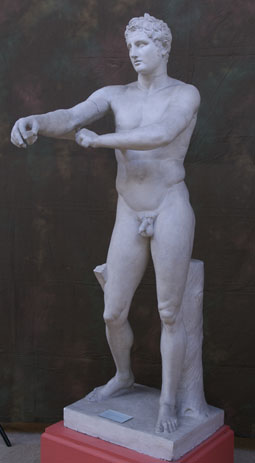
A figure of a young man scraping himself with a strigil, a curved metal instrument used to remove the excess oil that wrestlers and other athletes used to cover themselves in after their training.
The bronze original of this sculpture was by Lysippos and, according to Pliny, it was one of his most famous works. Pliny also wrote that whilst other sculptors made men as they are, Lysippos claimed to carve men as they appear, hence the longer limbs. The Roman emperor Tiberius liked the Apoxyomenos so much that he is supposed to have taken it from the Baths of Agrippa to his bedroom.
This Roman copy is remarkably well preserved; only the nose and the fingers, along with the inaccurate die in the right hand, are restorations
Rome, Vatican, Braccio Nuovo 67
Purchased from Malpieri of Rome in 1884
Lippold: Griechische Plastik, 279 (n.8), pl. 100.1
Walston: Catalogue of Casts in the Museum of Classical Archaeology (1889), 81, no.381
Richter: Three Critical Periods in Greek Sculpture, 17- & 20
Amelung: Catalogue of the Vatican Museum I (1903), 86-
Morgan: Hesperia, supplement VIII (1949), 228-
Found in the Trastevere in Rome in 1849
